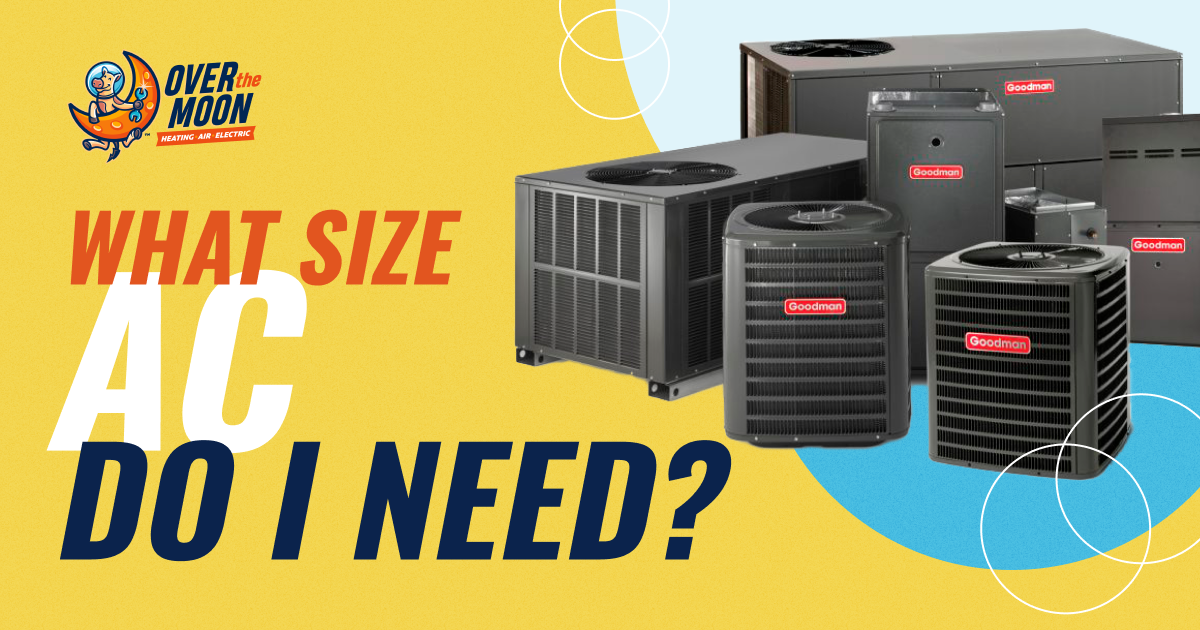Proper sizing is one of the greatest challenges to purchasing a new AC. If it’s too small, your home won’t get cool enough and the unit will work harder. Too big a unit can increase energy costs and lead to higher humidity; it will also short cycle, which increases wear and tear. Many guides to AC sizing imply you need a complex equation to avoid these issues. However, we’ll break down a few concepts to help you answer the question, “What size AC unit do I need?”.
What Is AC Size?
AC size does not pertain to a unit’s physical dimensions. Instead, an air conditioner’s size refers to its cooling capacity. The larger an AC, the higher its cooling capacity, which is measured in British Thermal Units (BTUs) or tonnage. We’ll now look at these terms more closely:
- BTU: A BTU is a measure of energy you need to raise the temperature of one pound of water by 1℉. With an air conditioner, this translates to how much energy it needs to cool a given space. British Thermal Units Per Hour (BTUh) is the number of BTUs an AC removes in an hour.
- Tonnage: Rather than heat energy, tonnage refers to the total amount of heat an air conditioner can remove in one hour. It can be used interchangeably with BTUh to identify an AC unit’s cooling capacity. Tonnage for air conditioners generally ranges from 1.5 to 5 tons, in .5-ton increments.
- Average Cooling Capacity: One ton of cooling capacity equals 12,000 BTUh. Therefore a 1.5- to 5-ton AC, the typical range for residential applications, provides 18,000 to 60,000 BTUh of cooling capacity. Larger units are more suited for offices, restaurants, retail buildings, and other light commercial applications.
How to Calculate AC Size
The simplest way to calculate the size air conditioner you need is to determine the square footage of a room (length x width) and multiply it by 20 BTU. For an AC that serves your entire home, you’ll need to add up the square footage of every room to get the size of your interior space.
But square footage alone doesn’t determine the ideal AC size. Ceiling height, sunlight, the number of windows and doors, type and quality of insulation, heat-generating appliances, and how many occupants in your home can impact cooling performance. A professional will use a Manual J load calculation to factor these variables into sizing a new unit.
While there are online calculators that can help, we strongly advise contacting an HVAC professional or energy auditor to visit and inspect your home. They will be more precise and avoid any errors you might make in performing calculations manually.
How Do I Determine an AC Unit’s Efficiency?
Homeowners often inquire about efficiency before asking, “What size AC unit do I need?” Fortunately, efficiency is calculated by AC unit manufacturers when engineering equipment. There’s no work for you to do except determine the best efficiency rating for your home and compare air conditioners that fall in that range.
An AC’s Seasonal Energy Efficiency Ratio, or SEER, is the metric that’s become standard in the industry. It’s calculated by dividing the total amount of cold air a central AC produces throughout the cooling season by the total amount of electricity it consumes. The SEER ratings of two air conditioners can be different despite them having the same cooling capacity.
In 2023, the minimum SEER rating increased to 14. Therefore, it’s not only the size of the AC unit you need but also the unit’s efficiency rating that must be considered.
Call Over the Moon to Size Your Next AC Unit
Finding out, “What size AC unit do I need?” doesn’t have to be stressful. At Over the Moon, our AC installation professionals use their expertise to determine what sized unit you need and what the best type of AC for your home is. We install packaged, split, and ductless mini-split systems and evaporative coolers. Our team also provides high-quality repair services and annual system tune-ups. Call 262-510-0956 to schedule service.

